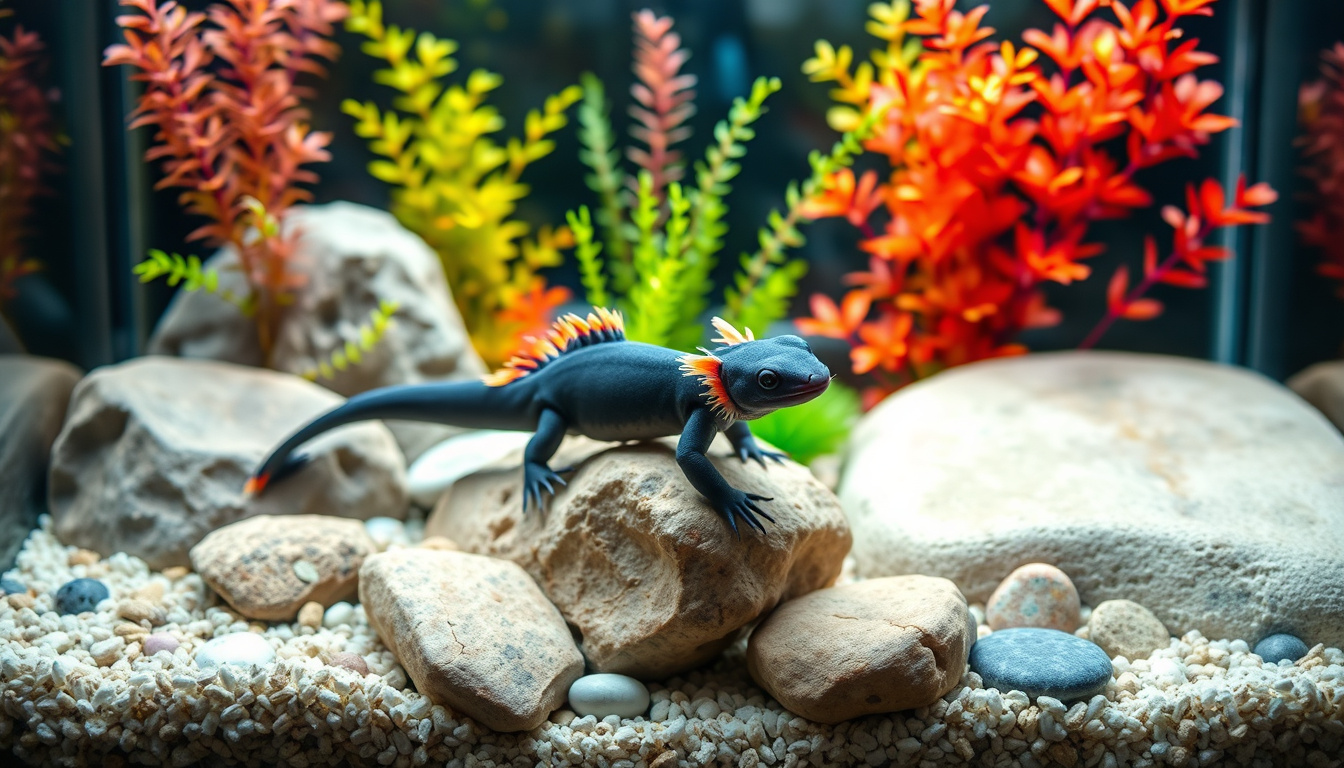Are you ready to dive into the fascinating world of axolotls?
These unique amphibians, often referred to as ‘Mexican walking fish,’ are not only captivating with their external gills and adorable faces, but they also make wonderful pets for aquarium enthusiasts.
Setting up the perfect axolotl aquarium requires knowledge and preparation, but don’t worry—this ultimate guide is here to help you get started.
Whether you’re a complete beginner or just looking to refine your aquarium skills, you’ll learn everything you need to create a thriving environment for your aquatic companion.
Let’s explore the essentials of an axolotl aquarium setup!


Water Quality Management: Filtration, Temperature, and pH Levels
Creating an ideal axolotl aquarium setup goes beyond merely picking a cool tank and décor.
One of the crucial aspects to consider is water quality management, which plays a vital role in ensuring your axolotl thrives in its new home.
First and foremost, filtration is essential; it helps to keep the water clean by removing debris and harmful toxins.
You should opt for a filter that maintains the ideal flow rate, as axolotls prefer calm waters.
Next, pay attention to water temperature, which should ideally be kept between 60°F and 68°F (16°C to 20°C).
Too much heat can stress these fascinating creatures, so invest in a reliable thermometer to monitor conditions.
Lastly, maintaining proper pH levels is critical, with a range of
6.5 to 8 being optimal for your axolotl aquarium setup.
Regular testing and adjustments can make a significant difference, allowing your axolotl to flourish while also avoiding potential health issues.
With the right approach to these water quality management elements, you can create a vibrant and healthy environment for your aquatic friend.
Decor and Substrate: Creating a Safe and Comfortable Environment
When you’re diving into the fascinating world of axolotl aquarium setup, understanding the importance of decor and substrate is essential for creating a safe and comfortable environment for these unique creatures.
Axolotls are sensitive amphibians that thrive in well-maintained aquariums, so choosing the right substrate is crucial.
Opt for a bare bottom tank or fine sand rather than gravel, as larger pebbles can be ingested and cause health issues.
Additionally, incorporating hiding spots such as driftwood, rocks, or aquatic plants can provide your axolotl with necessary shelter, helping them feel secure in their habitat.
Be sure to avoid sharp edges that could injure their delicate skin, and keep the decorations simple yet engaging.
By focusing on these elements in your axolotl aquarium setup, you’ll not only promote their well-being but also create an aesthetically pleasing environment that’s enjoyable to observe.
Frequently Asked Questions
What is the ideal aquarium size for an axolotl?
The ideal aquarium size for an axolotl is at least 20 gallons.
This provides enough space for them to swim and explore while also allowing for proper filtration and water management.
What type of filtration system is best for an axolotl aquarium?
A good filtration system for an axolotl aquarium is a sponge filter or a hang-on-back filter.
These options provide gentle water flow, which is crucial since axolotls prefer calmer waters.
What substrate should I use in my axolotl tank?
The best substrate for an axolotl aquarium is bare-bottomed or fine sand.
Avoid gravel, as axolotls might ingest it, which can lead to health issues.
How often should I feed my axolotl?
You should feed your axolotl 2-4 times a week, offering a varied diet that includes high-quality pellets, worms, and other protein-rich foods.
What water conditions are necessary for a healthy axolotl aquarium?
Maintain the water temperature between 60-64°F (16-18°C), pH levels between 6.5-7.5, and ensure low ammonia and nitrite levels.
Regular water testing and changes are essential to keep these levels stable.
[center][/center]
[center][color=rgb(10, 10, 10)][highlight=rgb(255, 248, 231)] [/highlight][/color][color=rgb(10, 10, 10)][highlight=rgb(255, 248, 231)]As an Amazon Affiliate,[/highlight][/color][color=rgb(10, 10, 10)][highlight=rgb(255, 248, 231)] [/highlight][/color][color=rgb(10, 10, 10)][highlight=rgb(255, 248, 231)]Savvy Keto makes a commission[/highlight][/color][color=rgb(10, 10, 10)][highlight=rgb(255, 248, 231)] [/highlight][/color][color=rgb(10, 10, 10)][highlight=rgb(255, 248, 231)](at no extra cost to you)[/highlight][/color][color=rgb(10, 10, 10)][highlight=rgb(255, 248, 231)] [/highlight][/color][color=rgb(10, 10, 10)][highlight=rgb(255, 248, 231)]on purchases you make[/highlight][/color][color=rgb(10, 10, 10)][highlight=rgb(255, 248, 231)] [/highlight][/color][color=rgb(10, 10, 10)][highlight=rgb(255, 248, 231)]thru links on this site.[/highlight][/color][/center]

